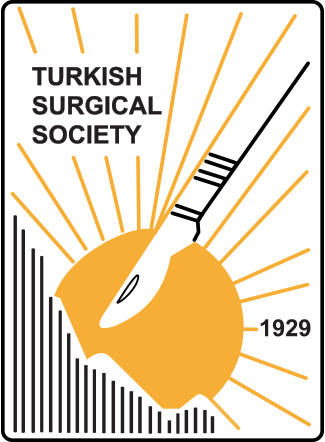Abstract
Purpose: The effects of growth hormone on bacterial translocation and on histopathologic changes both in the liver and small bowel together with the biochemical influences were aimed to investigate in a rat model of obstructive jaundice.
Materials and Methods: Twenty-four Wistar albino male rats were used in the study. Animals were randomised and divided into four groups: Group IControl, Group II Sham, Group III Obstructive jaundiced animals and Group IV Treatment group(GH). GH, 250 microgram per kg per day, was administered subcutanously for 10 days. Blood samples were obtained for measurments of bilirubin, ALT, AST, ALP and GGT on the operation day through cardiac puncture. BT was evaluated taking specimens from mesenteric lymph node, liver, spleen and cecum via laparotomy under sterile conditions.
Results: Statistically significant differerence was found between Treatment Group and other groups in terms of total and direct bilirubin levels(p<0.01). While ALT, AST and GGT levels in the Treatment Group were noted lower insignificantly comparing to those in the other groups, there was a significant difference between ALP levels of Treatment Group and others. Although structural disorders seen in the liver and small bowel manifested partial improvements in the Treatment Group, no statistically significant difference was found between the groups(p>0.05). While the BT rates were similar in Group III and Group IV, it was found decreased in the liver of the Treatment Group comparing to that of Jaundiced Group
Conclusion: It has been concluded that GH provides partial improvements in biochemical parameters and BT rates in obstructive jaundice. Once the trophic and cytoprotective effects of GH on the liver and small bowel combined with its systemic influences are taken into account, GH administration may lead to decrease in morbidity and mortality due to obstructive jaundice.
Keywords:
Growth hormone, bacterial translocation, obstructive jaundice
References
1Dıng JW, Andersson R et al: Obstructive jaundice impairs reticuloendothelial function and promotes bacterial translocation in the rat. J Surg Res,1994;57: 238-245.
2Reynolds JV, Murchan P et al: Gut barrier failure in experimental obstructive jaundice. J SurgRes, 1996;62:11-16.
3Floch MH, Gershengoren W et al: Bile acid inhibition of the intestinal microflora: A function for simple bile acids?. Gastroenterology, 1971;61: 228.
4Saito H, Inoue T et al: Growth hormone and the immune response to bacterial infection. Horm Res, 1996;45: 50-54.
5Thompson RLE, Hoper M,Diamond T,Rowlands BJ: Development and reversibility of T lymphocyte dysfunction in experimental obstructive jaundice. Br J Surg,1990;77:1229-1232.
6Greig J D, Krukowski ZH, Matheson NA: Surgical morbidity and mortality in one hundred and twenty-nine patients with obstructive jaundice. Br J Surg, 1998;75:216-221.
7Kuzu MA, Kale İT et al: Obstructive jaundice promotes bacterial translocation in humans. Hepatogastroenterology, 1999;46:2159–2164.
8Parks RW, Clements WDB et al: Bacterial translocation and gut microflora in obstructive jaundice. J Anat, 1996;189:561-565.
9Chen SMS, Chau P, Harris HW: Obstructive jaundice alters kupffer cell function independent of bacterial translocation. J Surg Res, 1998;80: 205-209.
10Çakmakcı M,Tırnaksız B et al: Effects of obstructive jaundice and external biliary diversion on bacterial translocation in rats. Eur J Surg, 1996;162:567-571.
11Wells CL, JecHorek RP et al. Bacterial translocation in cultured enterocytes: Magnitude, specificity and electron microscopic observations of endocytosis. Shock, 1994;1: 443-451.
12Ding JW, Anderson R et al: The role of bile and bile acids in bacterial translocation in obstructive jaundice in rats. Eur Surg Res, 1993;25:11–19.
13Wells CL, Jechorek RP et al: Inhibitory effect of bile on bacterial invasion of enterocytes: Possible mechanism for increased translocation associated with obstructive jaundice. Crit Care Med,1995;23:301-307.
14Kordzaya DJ, Goderdziahvili VT et al: Bacterial translocation in obstructive jaundice in rats:Role of mucosal lacteals. Eur J Surg, 2000;166:367-374.
15Schimpl G, Pesendorfer P et al: The effect of vitamin C and vitamin E supplementation on bacterial translocation in chronic portal hypertensive and common-bile-duct-ligated rats. Eur Surg Res, 1997;29:187–194.
16Cantürk NZ, Cantürk Z et al: Cytoprotective effects of alpha tocopherol against liver injury induced by extrahepatic biliary obstruction. East Afr Med J, 1998;75:77-80.
17Eizaguirre I, Aldazabal P et al: Effect of growth hormone, epidermal growth factor, and insulin on bacterial translocation in experimental short bowel syndrome. J Pediatric Surg, 2000;35: 692-695.
18Scopa CD, Koureleas S et al: Beneficial effects of growth hormone and insulin-like growth factor I on intestinal bacterial translocation, endotoxemia and apoptosis in experimentally jaundiced rats. J Am Coll Surg, 2000;190: 423-431.
19Yang ZW, Li JG et al: Effects of recombinant human growth hormone on intestinal translocation of bacteria and endotoxin in rats with obstructive jaundice. Hepatobiliary Pancreat Dis Int, 2005;4:445-449.
20Takala J,Ruokonen E et al: İncreased mortality associated with growth hormone treatment in critically ill adults. N Engl J Med, 1991;341: 785-792.



